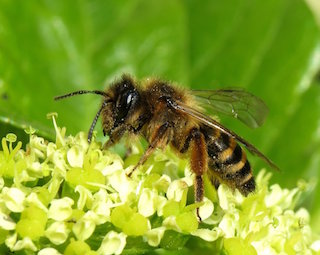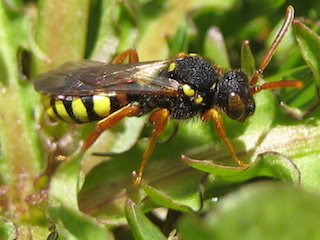 The first flight period of the Yellow-legged Mining Bee is in the spring, when you can spot them nectaring on flowers. You can also look out for their nests in exposed soil, looking like tiny drilled holes.
The first flight period of the Yellow-legged Mining Bee is in the spring, when you can spot them nectaring on flowers. You can also look out for their nests in exposed soil, looking like tiny drilled holes.
Photo: Andy Pay
Scientific name: Andrena flavipes
What to look for:
· Colouring and appearance: Thin yellow/creamy bands on black abdomen. Females have a thick covering of yellow hairs on their back legs, but the males do not and are slimmer.
· Size: Length, 10 to 12 mm.
· Where: Common in the southern parts of England and the south Welsh coast. It is also found in Europe, Asia and Africa.
· When: Two flight periods, from March to May and June to September. The earlier spring generation is more numerous.
 We think of bees as social creatures, but there are several solitary species, including mining bees. The Yellow-legged Mining Bee (Andrena flavipes) is a particularly common species in southern parts of the country, and can be seen as early as March on warmer days, nectaring on spring flowers such as the Alexanders that start to blossom in this season.
We think of bees as social creatures, but there are several solitary species, including mining bees. The Yellow-legged Mining Bee (Andrena flavipes) is a particularly common species in southern parts of the country, and can be seen as early as March on warmer days, nectaring on spring flowers such as the Alexanders that start to blossom in this season.
You can see their nests in the ground during the day, looking like little drilled holes, often (but not always) grouped together where vegetation is sparse and the habitat is exposed to the warmth of the sun. The female creates two to three brood cells in her nest. At night and in rain, the nest opening is sealed

Did you know…?
… Andrena flavipes has its own specific parasite – the cuckoo bee species Nomada fucata (see image to left). Cuckoo bees lay their eggs in nests of their host bee (this is called kleptoparasitism). The cuckoo bee larva eats the pollen collected by its host, and also tucks into the host’s own larva.
More information and references:
Chinery, M., 2005. Collins Complete Guide to British Insects. Collins, London.
Published: March 2016
Author: Amanda Scott
Photos: Andrena flavipes (Andy Pay); Nomada fucata (Floor Arts at waarneming.nl, a source of nature observations in the Netherlands. [CC BY 3.0], via Wikimedia Commons)
